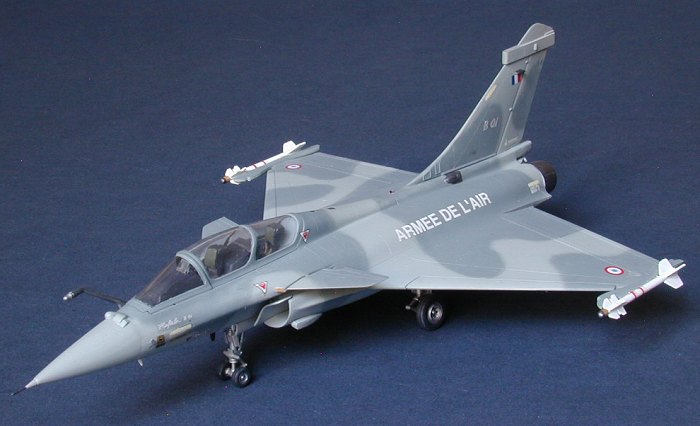
Italeri 1/72 Dassault Rafale B
|
KIT # |
? |
|
PRICE: |
€ 10.00 |
|
DECALS: |
one option |
|
REVIEWER: |
Lars Jřrgensen |
|
NOTES: |

|
HISTORY |
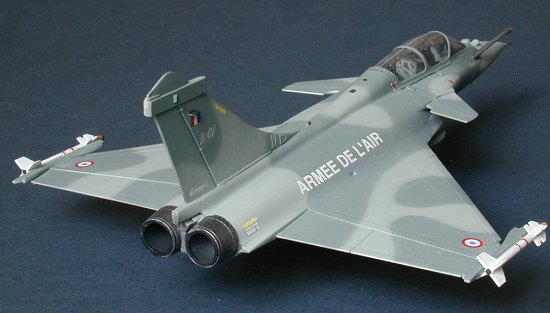 The Rafalé is the latest fighter aircraft from
France and may be the last from this country. Development started way
back together with several European partners, with an eye to a common
aircraft design. When the design was slowly defined, France was not
satisfied with what later to become the Eurofighter, opting for a smaller
aircraft. It was anticipated that such a smaller aircraft would have a
better chance on export markets, following on the Mirage success story.
The general layout follow that of the Mirage successors, adding a canard
to the delta. This close coupled canard configuration is used by all
three current European fighter designs. Two engines are used, maybe
influenced by the intended marine use.
The Rafalé is the latest fighter aircraft from
France and may be the last from this country. Development started way
back together with several European partners, with an eye to a common
aircraft design. When the design was slowly defined, France was not
satisfied with what later to become the Eurofighter, opting for a smaller
aircraft. It was anticipated that such a smaller aircraft would have a
better chance on export markets, following on the Mirage success story.
The general layout follow that of the Mirage successors, adding a canard
to the delta. This close coupled canard configuration is used by all
three current European fighter designs. Two engines are used, maybe
influenced by the intended marine use.
Well, maybe the Rafalé is a victim of the peace dividend. It was ordered into production as far back as 1992, but the aircraft have been tickling off the construction line due to restricted funds. Also, focus was shifted from a fighter to an attack aircraft, with more two-seaters on order. The Rafalé is purchased by the 'Armeé de l'Air' and the 'Aeronavale' in different versions:
§ Rafalé C (Chassé), single seat Armeé de l'Air fighter
§ Rafalé B (Biplace), two-seat trainer and attack aircraft for the Armeé de l'Air
§ Rafalé M (Mariné), the navalised Rafale for the Aeronavale
Up to date, no export orders have been won for the Rafalé, while Dassault is still offering their former design, the Mirage 2000, upgraded with some avionics developed for the Rafalé.
|
THE KIT |
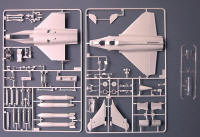 There are two main Rafalé kit lines available, one
in 1/48 from Revell and one in 1/72 from Italeri, I think Heller did also
a Rafalé prototype in 1/72 scale. Italeri has the maritime Rafalé M and
the two-seat Rafalé B on offer, which is used by the Armeé de l'Air. The
later kit is the subject for this review.
There are two main Rafalé kit lines available, one
in 1/48 from Revell and one in 1/72 from Italeri, I think Heller did also
a Rafalé prototype in 1/72 scale. Italeri has the maritime Rafalé M and
the two-seat Rafalé B on offer, which is used by the Armeé de l'Air. The
later kit is the subject for this review.
The light gray plastic parts come on two sprues, as
is typical for Italeri. Parts show good detail with finely raised panel
lines. As far as I could see, everything looks OK in comparison with the
real thing. Stores include two of the prominent big fuel tanks, two
Magic’s and four Micas,
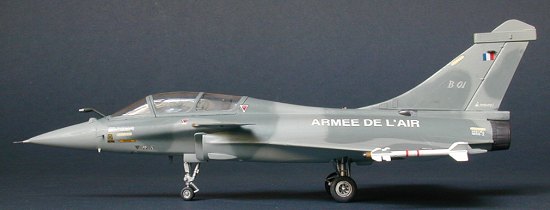 quite useable this time. Some sensor heads are
supplied, these may vary on the real aircraft as development continues.
Sensibly, these 'warts' are mounted flush to the airframe, leaving no
holes should they not be mounted. The clear parts include a two-piece
canopy and an internal windscreen. Decals are for a prototype ("B 01") in
a two-tone gray camouflage, which is featured in a lot of publicity
shots. There are not so many markings on the decal sheet but they look OK
to me.
quite useable this time. Some sensor heads are
supplied, these may vary on the real aircraft as development continues.
Sensibly, these 'warts' are mounted flush to the airframe, leaving no
holes should they not be mounted. The clear parts include a two-piece
canopy and an internal windscreen. Decals are for a prototype ("B 01") in
a two-tone gray camouflage, which is featured in a lot of publicity
shots. There are not so many markings on the decal sheet but they look OK
to me.
I had a look in the Italeri M kit, this being a single seater. Apart from the obvious different cockpit this has the stronger gear and hook. By cross-kiting these two it should be possible to get more Rafalé variants.
The usual Italeri joke are this time the cockpits, which are much too shallow. Accordingly, the ejection seat backs are ridiculous short.
|
CONSTRUCTION |
Construction started with prepainting some smaller
parts while they where still attached to the sprue. Then the panel lines
where removed on major parts and rescribed. If stores are to be used,
holes are to be opened in the lower airframe part to take up the pylons.
No stores, no holes to fill, that's how it has to be, and I went this way
as I wanted a clean airframe. The
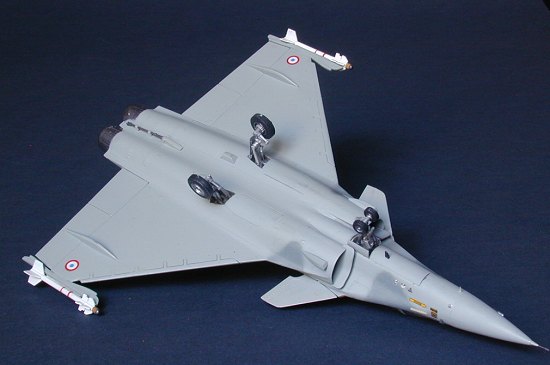 external stores went in the spares box,
they will be useful for other French aircraft as for example the Mirage
2000.
external stores went in the spares box,
they will be useful for other French aircraft as for example the Mirage
2000.
I searched for new ejection seats in the spares box, but found none. So I modified the kit's seats by lengthening the seat backs, which came out quite well. Some color came on and tape belts where added. To take the seats the cockpit floors had to be removed. With the corrected seats in, now the side panel are too high...this is a cockpit which would benefit from a resin replacement.
With the rest of the cockpit painted up and installed, the upper and lower half of the airframe where joined, fit was good as with these parts. Construction went on quickly as the parts were added to the airframe. Some filler was needed here and there to hide seams. The intakes are quite nicely done. Some scrap metal was put in the radar nose as ballast to avoid tail-sitting. The sensors 'warts' where added, as no positions where given this had to be done checking plans and references for the correct placement. With all major parts added it was time for some masking and then on to painting.
|
COLORS & MARKINGS |
Painting started with a primer coat of MM gray primer and a cleanup of defects. Smaller parts where sprayed separate. The canopy was masked with Parafilm and got some black sprayed on, repesenting the internal framing. The exhausts, already attached, got sprayed with some Humbrol polished steel. After masking these, everything was sprayed FS36375 'Light Ghost Gray' following the instructions. Next came Humbrol's 145 'Medium Grey', FS 35237, again as per instructions. Lazy as I was I sprayed the camouflage pattern freehand, although some 'soft edge' masking may be more correct. The grays look very nice to me, having just the right tint of blue.
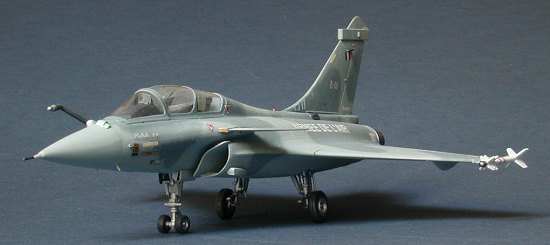 With the paint applied, the decals followed, again
being lazy I skipped the gloss preparation coat, but I had luck, as I got
no silvering. Concerning the decals, I think they are not so correct, but
I had no choice. Let's suppose the prototype looked this way one point,
although I could not find a matching picture, I think the 'ARMEE DE L'AIR'
title is to big. There are not that many decals at all. Common to French
aircraft, you get some information about maker and name of the airframe
and the engine.
With the paint applied, the decals followed, again
being lazy I skipped the gloss preparation coat, but I had luck, as I got
no silvering. Concerning the decals, I think they are not so correct, but
I had no choice. Let's suppose the prototype looked this way one point,
although I could not find a matching picture, I think the 'ARMEE DE L'AIR'
title is to big. There are not that many decals at all. Common to French
aircraft, you get some information about maker and name of the airframe
and the engine.
The Magic missiles where sprayed white and given some color, then added to the wingtips. The refueling probe came on, again there was no locating hole and the probe had to be positioned carefully, needing some filler. After another cleaning it was time for a coat of Tamiya's Clear with some Flatener, giving a nice, tough satin finish and blending in the decals. The masking came off and the gears where mounted and left to dry. Then some small parts where added to live the kit a bit up.
|
CONCLUSIONS |
Well, the result looks not bad to me. I rescribed the panel lines and modified the cockpit, otherwise the kit gives a good representation. The detail could be better here and there, and Italeri has showed they could do some better kits. But I think the look is quite well captured, and the kit is not expensive and quick to build. So if you are for the latest in French fighter technology, go ahead with this one.
June 2004
Copyright ModelingMadness.com.
If you would like your product reviewed fairly and fairly quickly, please contact the editor or see other details in the Note to Contributors.